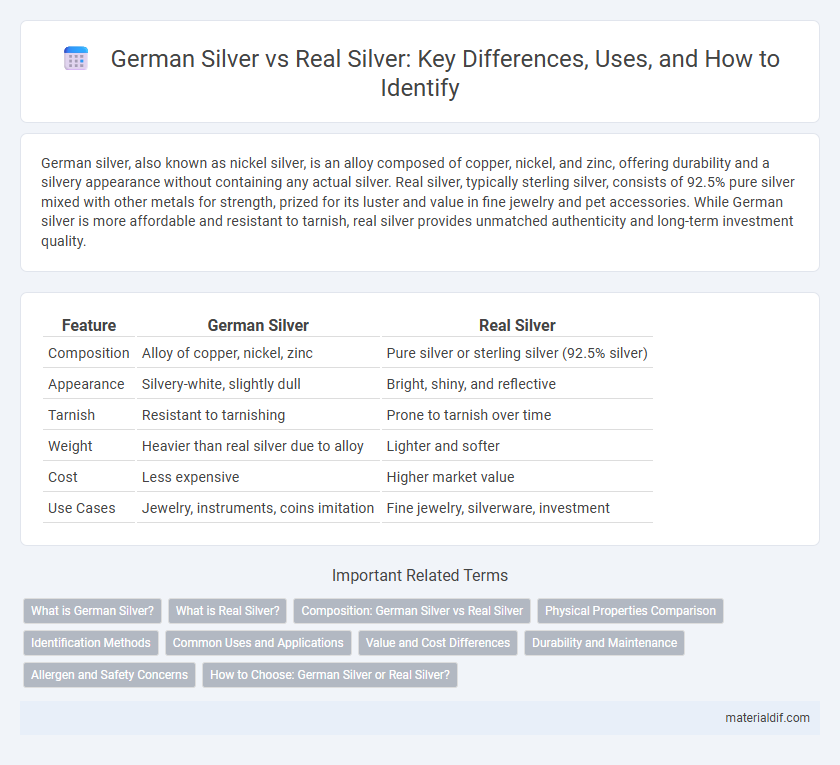German silver, also known as nickel silver, is an alloy composed of copper, nickel, and zinc, offering durability and a silvery appearance without containing any actual silver. Real silver, typically sterling silver, consists of 92.5% pure silver mixed with other metals for strength, prized for its luster and value in fine jewelry and pet accessories. While German silver is more affordable and resistant to tarnish, real silver provides unmatched authenticity and long-term investment quality.
Table of Comparison
| Feature | German Silver | Real Silver |
|---|---|---|
| Composition | Alloy of copper, nickel, zinc | Pure silver or sterling silver (92.5% silver) |
| Appearance | Silvery-white, slightly dull | Bright, shiny, and reflective |
| Tarnish | Resistant to tarnishing | Prone to tarnish over time |
| Weight | Heavier than real silver due to alloy | Lighter and softer |
| Cost | Less expensive | Higher market value |
| Use Cases | Jewelry, instruments, coins imitation | Fine jewelry, silverware, investment |
What is German Silver?
German silver, also known as nickel silver, is an alloy composed of copper, nickel, and zinc, without any actual silver content. Unlike real silver, which primarily consists of pure silver or sterling silver containing 92.5% silver, German silver mimics the appearance of silver but is more affordable and resistant to tarnish. This alloy is commonly used in jewelry, musical instruments, and cutlery due to its durability and silver-like shine.
What is Real Silver?
Real silver, also known as fine silver or sterling silver, is a precious metal composed of at least 92.5% pure silver mixed with copper or other metals to enhance durability and strength. Unlike German silver, which contains no actual silver and is an alloy of copper, nickel, and zinc, real silver retains intrinsic value due to its high purity and rarity. Its distinct luster, malleability, and antimicrobial properties make genuine silver highly desirable in jewelry, tableware, and investment markets.
Composition: German Silver vs Real Silver
German silver, also known as nickel silver, primarily consists of copper, nickel, and zinc, typically containing about 60% copper, 20% nickel, and 20% zinc, without any actual silver content. In contrast, real silver is composed of sterling silver, which contains 92.5% pure silver and 7.5% other metals, usually copper, to enhance durability while maintaining high silver purity. The distinct compositions impact their appearance, corrosion resistance, and value, with real silver being more precious due to its genuine silver content.
Physical Properties Comparison
German silver, also known as nickel silver, contains copper, nickel, and zinc, giving it a silver-like appearance but lacking actual silver content. Real silver, primarily composed of 92.5% silver in sterling form, exhibits higher malleability, a brighter luster, and superior conductivity compared to German silver. In terms of weight, real silver is denser, making it noticeably heavier than the lighter German silver alloy.
Identification Methods
German silver, an alloy composed primarily of copper, nickel, and zinc, lacks any actual silver content, making identification dependent on testing for metal composition rather than hallmark verification. Real silver, often sterling silver, is typically identified by its distinct hallmarks such as "925" or "Sterling," magnetic tests showing non-magnetic properties, and the use of acid tests to confirm the presence of silver. Advanced methods like X-ray fluorescence (XRF) analyzers provide precise differentiation by detecting elemental composition, ensuring accurate identification between German silver and genuine silver items.
Common Uses and Applications
German silver, also known as nickel silver, is commonly used in jewelry, musical instruments, and cutlery due to its durability and resistance to tarnish. Real silver, primarily sterling silver, is highly valued in fine jewelry, silverware, and collectible coins for its purity and antimicrobial properties. While German silver offers cost-effective alternatives with a similar appearance, real silver remains preferred for applications requiring genuine precious metal qualities.
Value and Cost Differences
German silver, also known as nickel silver, contains no actual silver and is primarily composed of copper, nickel, and zinc, making it significantly less valuable than real silver, which is typically 92.5% pure silver in sterling silver items. The cost difference is substantial, with German silver being more affordable due to its base metal content while real silver commands higher prices driven by its precious metal status and market demand. Real silver also appreciates over time, whereas German silver holds mostly ornamental value without investment potential.
Durability and Maintenance
German silver, an alloy composed primarily of copper, nickel, and zinc, offers superior durability compared to real silver due to its resistance to tarnish and corrosion. Real silver, typically 92.5% pure silver (sterling silver), requires regular polishing and careful maintenance to prevent oxidation and maintain its luster. The low maintenance and robust hardness of German silver make it ideal for items subject to frequent handling, whereas real silver demands more delicate care to preserve its appearance and value.
Allergen and Safety Concerns
German silver, an alloy composed of copper, nickel, and zinc, often triggers allergic reactions due to its high nickel content, making it unsuitable for individuals with metal sensitivities. Real silver, particularly sterling silver (92.5% pure silver), is hypoallergenic and generally safe for most wearers, reducing the risk of skin irritation and allergic responses. Choosing real silver minimizes safety concerns associated with prolonged skin contact, especially for those prone to metal allergies.
How to Choose: German Silver or Real Silver?
Choosing between German silver and real silver depends on your requirements for durability, appearance, and budget. German silver, an alloy of copper, nickel, and zinc, offers greater resistance to tarnish and corrosion, making it ideal for everyday items and costume jewelry. Real silver, primarily sterling silver with 92.5% pure silver, provides authentic luster, hypoallergenic properties, and higher intrinsic value, preferred for fine jewelry and collectibles.
German silver vs Real silver Infographic

 materialdif.com
materialdif.com